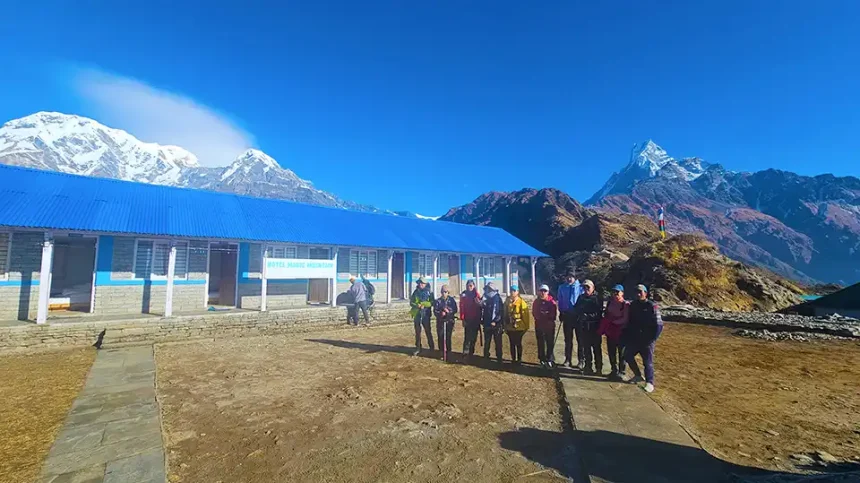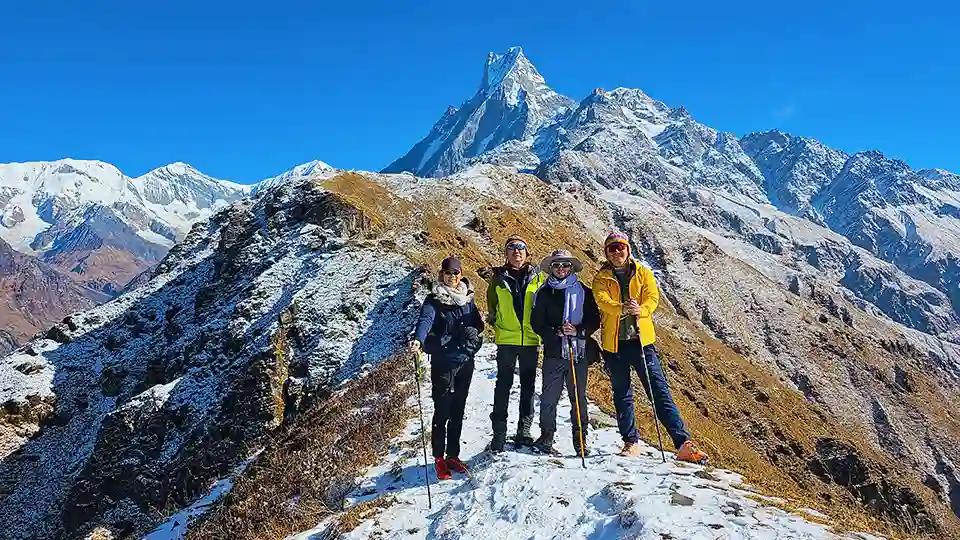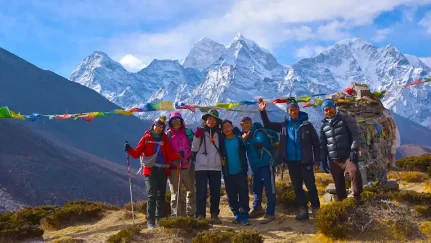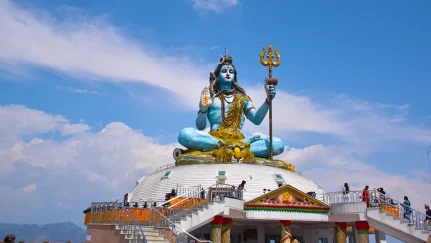Introduction
Mardi Himal Trek is not as exposed or famous as some of the other treks in Nepal. However, it is quickly gaining recognition as a must-do trek for those looking to explore the Annapurna region without crowds. This trek is a perfect mixture of adventure with Himalayan scenes and unique cultural experiences. Hence, with its unique closeup mountain views, varied landscapes, and a sense of peacefulness, the Trek is an excellent choice for both seasoned trekkers and beginners alike.
- Mardi Himal High Camp Close-up View
If you don’t know, the trek altitude reaches a maximum of 4,500 meters at Mardi Himal Base Camp and offers amazing views of Machapuchare (Fishtail), Annapurna South, and other giant peaks. Therefore, as you reach this greater height, it is essential for you to understand the trek elevation profile, altitude gain, and distance so that you can make the most of the journey. Hence, in this blog, we will provide a detailed guide to help you with the dynamics of the trek elevation profile, altitude gain, and distance, so that you can prepare for the challenges ahead for your journey. So, let’s get started-
Trek Elevation Profile and Altitude Gain
The Trek involves significant altitude changes, with gradual ascents through varied landscapes. Below is a breakdown of the key stops along the route, their respective altitudes, and the altitude gain between them:
Day 1: Arrival in Kathmandu
- Elevation: 1,400 meters
Day 2: Flight from Kathmandu to Pokhara (905m) and Trek to Deurali (2,100m)
- Altitude Gain: 1,195 meters
- Your journey begins with a scenic flight from Kathmandu to Pokhara, followed by a drive to Kande and then a trek to Deurali.
Day 3: Trek from Deurali to Forest Camp (2,520m)
- Altitude Gain: 420 meters
- From Deurali, the trail gradually ascends through dense rhododendron forests to reach Forest Camp.
Day 4: Trek from Forest Camp to Low Camp (3,035m)
- Altitude Gain: 515 meters
- The trek from Forest Camp to Low Camp takes you through more forested areas, but as you ascend, you’ll start to catch glimpses of the Annapurna South and Machapuchare (Fishtail) peaks.
Day 5: Hike from Low Camp to High Camp (3,580m)
- Altitude Gain: 545 meters
- Leaving the tree line behind, the trek from Low Camp to High Camp offers spectacular views of the surrounding mountains.
Day 6: Trek from High Camp to Mardi Himal Base Camp (4,500m) and Back to High Camp
- Altitude Gain: 920 meters (ascent)
- Altitude Loss: 920 meters (descent)
- The trail is steep and challenging, but the reward is a panoramic view of Annapurna, Machapuchare, and other Himalayan giants.
Day 7: Hike from High Camp to Sidding (1,750m)
- Altitude Loss: 1,830 meters
- The descent from High Camp to Sidding is a long but scenic trek, taking you through lush forests and traditional villages.
Day 8: Trek from Sidding to Lwang (1,460m)
- Altitude Loss: 290 meters
- The trek from Sidding to Lwong is relatively easy, with a gradual descent through terraced fields and small settlements.
Day 9: Trek from Lwang to Pokhara (905m)
- Altitude Loss: 555 meters
- On the final trekking day, you’ll descend to the road and take a short drive back to Pokhara.
Day 10: Pokhara Sightseeing and Flight Back to Kathmandu
- Elevation: 1,400 meters
Day 11: Sightseeing in Kathmandu and Final Departure
- Elevation: 1,400 meters
Mardi Himal Trek Distance Breakdown
The total distance of the Trek varies depending on the specific route taken, but it generally spans around 65-70 kilometers. Here’s a more detailed breakdown of the distances covered each day:
- Pokhara to Kande to Deurali: 8 km
- Deurali to Forest Camp: 8 km
- Forest Camp to Low Camp: 6 km
- Low Camp to High Camp: 4 km
- High Camp to Mardi Himal Base Camp and back: 10 km (round trip)
- High Camp to Sidding: 10 km
- Sidding to Lwong: 8 km
- Lwong to Pokhara: 7 km trek, followed by a short drive
Total Ascent Distance: Approximately 60-65 km
Total Descent Distance: Approximately 60-65 (similar route back)
This breakdown gives you a clear understanding of the trek’s distances and helps you plan your daily hikes.
Mardi Himal Altitude Map
- Mardi Himal Trek Altitude Map
From Which Elevations Can You See the Different Mountains in the Mardi Himal Trek?
One of the highlights of the Trek is the mesmerizing views of the Himalayas that come right before your eyes as you ascend. Here’s a breakdown of the key Trek elevation points and the mountains visible from those points:
| Mardi Himal Trek Elevation (meters) | Key Mountains Visible |
|---|---|
| 2,100 | Annapurna South, Hiunchuli, Machapuchare (Fishtail) |
| 2,520 | Annapurna South, Hiunchuli, Machapuchare |
| 2,970 | Annapurna South, Hiunchuli, Machapuchare |
| 3,580 | Annapurna South, Machapuchare, Mardi Himal |
| 4,500 (Mardi Himal Base Camp) | Annapurna I, Annapurna South, Machapuchare, Mardi Himal |
As you ascend, the views become more clearer and bigger, with the snow-capped peaks dominating the horizon. The best views of Machapuchare (Fishtail) and Mardi Himal are from High Camp and the Mardi Himal Base Camp.
- Mardi Himal Captured Whilst on Route
Comparison Table of Altitudes of Best Treks in Nepal
| Trek Name | Starting Elevation (meters) | Highest Elevation (meters) | Total Distance (km) | Total Days |
|---|---|---|---|---|
| Mardi Himal Trek | 905 | 4,500 | 70-80 | 9-11 |
| Annapurna Base Camp Trek | 1,070 | 4,130 | 70-100 | 7-12 |
| Everest Base Camp Trek | 2,640 | 5,364 | 130-150 | 12-16 |
| Annapurna Circuit Trek | 800 | 5,416 | 160-230 | 12-21 |
| Langtang Valley Trek | 1,430 | 3,870 | 70-80 | 7-11 |
| Manaslu Circuit Trek | 700 | 5,160 | 177-200 | 14-20 |
Conclusion
Hence, we want to say that, the Mardi Himal trek is one of the most favorite treks among the locals because of its unique features and shorter trekking days than other popular treks. Since it has been able to capture the minds of the locals who regularly see the other mountains of the country, then there is no reason that it won’t capture the minds of international tourists with its incredible landscapes. So, whether you’re an experienced or a beginner trekker, the Trek provides a great trekking experience in the Annapurna Region.
Furthermore, if you are interested in setting out on a Trek Journey, you need to prepare and handle a variety of legal tasks and processes. We therefore make trekkers’ and adventurers’ jobs easier by providing a variety of customized standard packages and trips. Therefore, if you have any queries or concerns regarding thisTrek or any other trek, then you can reach us by phone at +977-9841965533 or by landline at +977-14700252. Also, as an alternative, you can reach us by messaging us via WhatsApp or sending an email to info@missionhimalayatreks.com. Happy Trekking!



















